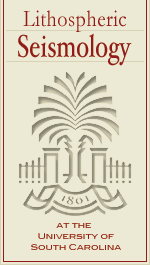Software
In the seismology program at the University of South Carolina we have an active software development effort. Current projects are listed below.
-
Seisplotjs
Seisplotjs is a javascript library for retrieving, processing and displaying seismic data in the browser. There are some examples available. -
TauP
TauP is a seismic travel time calculator. In addition to travel times, it can calculate derivative information such as ray paths through the earth, pierce and turning points. It handles many types of velocity models and can calculate times for virtually any seismic phase with a phase parser. -
Standing Order for Data
 SOD, Standing Order for Data,
is a framework to define rules to select seismic events, stations, and data.
It then allows you to apply processing to the events, stations, and data
and currently contains a large set of rules that allow you to select with
great precision in these items. The processes mainly consist of simple
data transformation and retrieval, but SOD defines hooks to allow you to
cleanly insert your own processing steps, either written in Java or an
external program.
SOD, Standing Order for Data,
is a framework to define rules to select seismic events, stations, and data.
It then allows you to apply processing to the events, stations, and data
and currently contains a large set of rules that allow you to select with
great precision in these items. The processes mainly consist of simple
data transformation and retrieval, but SOD defines hooks to allow you to
cleanly insert your own processing steps, either written in Java or an
external program.
-
SeedCodec
SeedCodec is a library of seismic compression and decompression routines in java. Currently support is for Steim1 compression, and decompression of Steim1 and 2, dwssn, cdsn and sro. More information can be found here. -
seisFile
SeisFile is a library for reading and writing seismic file formats in java. Currently support is for SAC, MSEED and PSN. More information can be found here.
Retired Projects
These projects have been retired, and are listed here for historical purposes, but are no longer maintined and should no longer be used.
-
DHI/FISSURES
Most of our software uses the FISSURES framework. The goal of the FISSURES Project is to provide a framework for seismology software and data transmission based on CORBA and the Java Platform that are developed in an open and cooperative fashion and released under the terms of the Gnu Public License. We have chosen to include an informational page for other software developers. -
The Global Earthquake Explorer
 GEE, the Global Earthquake Explorer, is an educational tool we have developed in order for non-seismologists
to retrieve, display, and analyze seismic data. The program also contains three structured learning modules that use classic earthquakes to
demonstrate important principles of seismology.
GEE, the Global Earthquake Explorer, is an educational tool we have developed in order for non-seismologists
to retrieve, display, and analyze seismic data. The program also contains three structured learning modules that use classic earthquakes to
demonstrate important principles of seismology. -
The Rapid Earthquake Viewer
 The Rapid Earthquake Viewer (REV) gives you access to data from seismograph stations around the world. REV monitors the earth and posts information about recent earthquakes so you can see where they happened and view the seismograms from global seismograph stations for every notable earthquake.
The Rapid Earthquake Viewer (REV) gives you access to data from seismograph stations around the world. REV monitors the earth and posts information about recent earthquakes so you can see where they happened and view the seismograms from global seismograph stations for every notable earthquake. -
USArray Monitor
The USArray Monitor shows data recorded by stations in the USArray Network. You can see recent earthquakes the stations have picked up or simply view 24 hours of data at a particular station.
